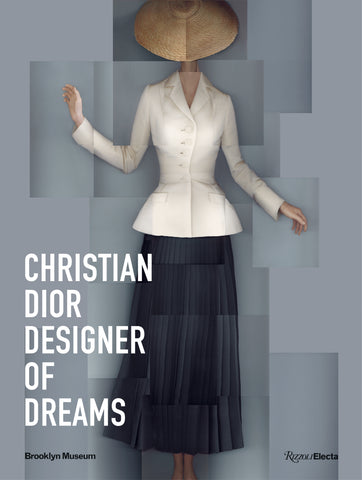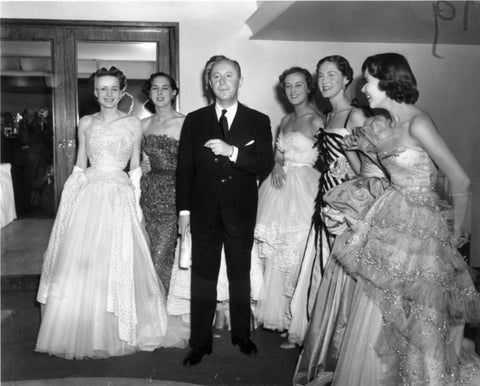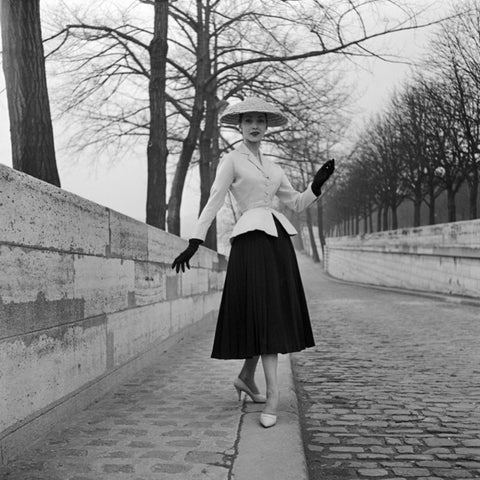SEVENTY FIVE YEARS OF THE HOUSE OF DIOR
February 12, 1947 was the day when a new modern fashion era began - on this day Christian Dior presented his first collection with a Bar suit as his signature design. It was christened “The New Look” by American journalist and editor-in-chief of Harper’s Bazaar, Carmel Snow. This look marked a new post-war era in fashion and Christian Dior’s legacy is alive today more than ever. To commemorate 75 years from the premier of The New Look and founding of the House of Dior, we will discuss designer’s story and artistry, innovations and collaborations, iconic looks and products, and his everlasting fashion heritage.
Christian Dior was born on January 21, 1905 in a seaside town of Granville on the coast of Normandy in a wealthy family. His father, Maurice Dior, was a fertilizer manufacturer. He and his wife Madeleine had five children, where Christian was the second. When he was 5 years old, the family moved to Paris. Madeleine Dior was famous for hosting excellent dinner parties, with butlers in white gloves, and praised for her exquisite taste in design and flowers. She loved flowers and became an exemplar gardener, when the family moved back to Grenville at the outbreak of the World War I in 1914. Madeleine Dior had a great influence on her son Christian, on building his taste and his aesthetic preferences.

According to the book Christian Dior: Designer of Dreams (Rizzoli Electa), “Nature and gardens were one of Christian Dior’s lifelong passions. As a boy, he would spend hours in the garden, and he helped his mother design the gardens at his family home in Granville, France, which he credited as a prominent influence on his work. He imagined or sketched many dresses in the garden, where he found inspiration in flowers, the changing of the seasons, and the rebirth of nature. From embroidery motifs to the flowerlike silhouettes of the New Look, flowers have bloomed in Dior’s creations” [1]. He even said, ‘I designed clothes for flower-like women’ and ‘after women, flowers are the most lovely thing God gave to the world’.


Although his parents had hopes of him becoming a diplomat, Dior was very artistic. Upon leaving school, Dior took over a small art gallery which his father bought for him, where he and a friend sold work by artists including Pablo Picasso. But after the Great Depression and his mother’s untimely death, he had to close the gallery. He was selling his own fashion illustrations to Le Figaro, the oldest newspaper in France, and to renowned fashion houses, including Schiaparelli and Balenciaga, and went to work with a fashion designer Robert Piguet until he was called up for military service in 1940. He finished the service in 1942 and began working for couturier Lucien Long, where he and Pierre Balmain were the primary designers. At the same time his dear sister Catherine, with who he was very close, served as a member of the French Resistance, was captured by the Gestapo, and sent to the Ravensbrück concentration camp, where she was incarcerated until her liberation in May 1945. After the end of the war, Catherine Dior spent the remainder of her life working with flowers: first as a flower trader in Paris, then as a flower farmer in Provence for the production of fragrance.

In 1946 Marcel Boussac, a successful entrepreneur, cotton-fabric magnate, known as the richest man in France, invited Dior to design for Philippe et Gaston, a Paris fashion house. Christian Dior refused, wishing to make a fresh start under his own name rather than reviving an old brand. On the 8th of December 1946, with Boussac's backing, Dior founded his fashion house but officially, the house of Dior considers 1947 to be the year of conception as that was when Dior showed his first collection. On the 12th of February 1947 he presented his first collection, named Corolle (literally the botanical term corolla or circlet of flower petals in English). But it was an American journalist, Carmel Snow, who baptized it as a “New Look”. She said: “Your dresses have such a new look!”, epitomized by the shapely Bar suit. On returning to the United States, she was the one who championed this new French fashion genius, “compelling American journalists and buyers, who had stopped following the diktats of Parisian couturiers during the war, to turn their gaze back to Paris” [1]. As Christian Dior was crowned with global renown, Paris’s role as the leading light of international fashion was restored. Following this success Dior opened his first subsidiary in 1948 in New York.

Alongside his premiere collection, in 1947 Christian Dior also presented his first perfume, Miss Dior, as he felt that a women’s outfit was never complete without perfume. The salons of the Corolla aka The New Look presentation were perfumed with Miss Dior, which smelled of a concoction of rose, gardenia, and jasmine with moss. The first fragrance famously was named after his beloved sister, Catherine. According to the legend, she entered the room while her brother Christian was brainstorming names for the perfume, when his muse Mizza Bricard noticed her and announced "Ah, here's Miss Dior!", and Christian allegedly replied "Miss Dior: now there's a name for my perfume!"


And this is how the House of Dior was born and it became the greatest Parisian couture house at its time! The New Look became extremely popular, its full-skirted silhouette influencing other fashion designers well into the 1950s, and Dior gained a number of prominent clients from Hollywood to the United States, royalty and the European aristocracy. Rita Hayworth, Grace Kelly, Princess Margaret and Marlene Dietrich - all loved his gowns. The latest took Dior on set with her: “No Dior, no Dietrich,” she told Alfred Hitchcock before filming Stage Fright with him in 1950 [1]. The House of Dior is tightly intertwined with the movie industry up until today, when so many actresses get their Academy Awards in the gowns with his name on the tag, from Elizabeth Taylor in 1961 to Jennifer Lawrence in 2013.


Christian Dior had been working for his fashion house for only a decade - he died of a sudden heart attack while on a spa vacation in Montecatini, Italy, on the 24th of October 1957. He was only 52 years old.

YVES SAINT LAURENT for CHRISTIAN DIOR
Young aspiring designer Yves Mathieu Saint Laurent was introduced to Christian Dior at the age of nineteen, and took a post as his assistant in the studio in June 1955, leaving behind Ecole de la Chambre Syndicale only after one term there. He dropped his middle name and became known as Yves Saint Laurent. After Monsieur Dior’s sudden death in 1957 he was named the new head designer, which came to a surprise as he was only twenty one years old. Although, according to Saint Laurent’s mother, Dior named Yves as his successor to her in a private conversation.
His debut collection as the head of the couture house introduced a new silhouette for Dior, named “Trapeze” as it ignored the waistline - a total opposition of Christian Dior’s emphasized waist and signature New Look silhouette. Yves made the clothes free-flowing and gave them youth and spirit by lightning them up and shortening the hemline. Despite the commercial success, there were inner tensions in the company. In 1960, the young designer was conscripted to the French Army to fight in the Algerian War of Independence. That was an excuse for Dior’s top management to let him go, as they didn’t receive his last collections well with too much of a youth spirit and colour black [3]. Marc Bohan was named the head designer, and Yves was offered to design ready-to-wear for Dior in London, which he saw as a humiliation and refused. From the money won from the House of Dior in a lawsuit for a breach of contract and backing from American millionaire Jesse Mack Robinson [3], Yves Saint Laurent opened his own fashion house, which celebrates 60 years in 2022.

Marc Bohan stood the test of time and was in charge of the House of Dior’s creations until 1989. For three decades, he was the longest-serving Creative Director of the House of Dior, replaced by Gianfranco Ferré, and then John Galliano took the reins in 1996. In 2011 Raf Simmons was appointed as a Creative Director of the House of Dior. Currently, since 2016, for the first time the fashion house has been run under a female direction of Maria Grazia Chiuri, an Italian designer, previously working for Valentino. Her use of Chimamanda Ngozi Adichie’s essay “We Should All Be Feminists” in the presentation and literally, on T-shirts, of the Spring–Summer 2017 collection has became a signature and motto of our times. She keeps women at the heart of her creative process, thus, as writers believe, honoring the codes of Dior [1] while offering a new vision of fashion for a new generation.





ROGER VIVIER for CHRISTIAN DIOR
Another notable artistic connection of Christian Dior was his ten-year collaboration with a shoemaker Roger Vivier. It began in 1953 when Dior saw in Vivier a designer whose aesthetic evokes his own. Their unique harmony was acknowledged by Christian Dior when he placed Vivier’s name alongside his own on the label of Dior footwear, an exceptional honour as at that time fashion collaborations and productions were functioning under licensing deals. Prior to 1953 Dior had his shoes made by a variety of shoemakers including Georges Mad, David Evins and the celebrated Andre Perugia, but he was too famous in his own right at that time. What Dior needed was a shoes designer with superior skills and natural elegance who should work for him directly. The shy, elegant and supremely talented Roger Vivier was a perfect fit [2].
The first shoes Vivier created for Dior debuted in July with the Autumn-WInter collection of 1953. According to the edition “Dior by Roger Vivier” (Rizzoli) Vivier’s shoes embodied age romance and luxury of France’s aristocratic past, yet remained firmly modern in both their architecture and ornamentation. The shoes were very popular on both continents. In 1956, the US custom-made shoes cost $150 (around $1400 today) while pret-a-porter Dior models from Paris adapted to the American foot were available for a fraction of the price at $35, which is around $325 today [2].

Under Yves Saint Laurent’s direction, Vivier renewed his contract with the House of Dior for another 5 years, and after that expired, the shoemaker maintained relationship with Saint Laurent and even designed now-iconic Pilgrim buckle shoes for his famous Mondrian Collection in 1965.
Fun fact- before Vivier turned his full attention to Dior, he had a very important commission to complete - the coronation shoes for the future Queen of England, Elizabeth II.
ICONIC HANDBAGS
Although Christian Dior is a couture house and focuses on fashion, it produces desired and covetable handbags. Let’s have a look at the history of their most important current purses.
As we discussed earlier in our blogs, the most famous Dior handbag is Lady Dior, popularized and named after Lady Diana. According to the fashion legend, during Princess Diana’s visit to Paris in 1995 for Cezanne Art Exhibition, the First Lady of France, Madame Bernadette Chirac, gave Lady Di, the latest handbag design by Dior, as a diplomatic gift. Created in 1994 under the creative direction of Gianfranco Ferre, the tote was first called “Chouchou,” which means “Favorite” in French. Lady Diana fell instantly in love with the bag, and as the most photographed woman in the world, the bag was highly photographed on the arm of one of the world’s most beloved woman of all time. Marie Claire magazine reports that the late Princess loved it so much, she ordered the bag in every colour. She has been photographed wearing the variation of the bag multiple times, for official, gala and state visits. Most memorably she paired it with a tangerine Versace suit on a visit to Liverpool that year, and with a John Galliano for Dior slip dress to the Met Gala in 1996, devoted to 50 years of Christian Dior. The Lady Dior handbag became an instant success. This was the time when Lady Di’s divorce from Prince Charles finalized, so the handbag also became a symbol of her new-found freedom, both personal and sartorial.

In honour of Lady Di, the house of Dior decided to rename its iconic bag and pay tribute to the Princess of Wales, and since 1996, the bag has been known as the “Lady Dior” handbag.
The Saddle bag has become a signature bag of Y2K (Year 2000’s) fashion as it premiered on the Spring-Summer 2000 runway and took the world by the storm. It was designed by John Galliano in 1999, for his cowboy-inspired collection. Though Galliano has never confirmed it, the bag is believed to be inspired by Helmut Newton’s “Saddle I, Paris” (1976) – a racy black-and-white photograph of a model posed on her hands and knees with a horse saddle harnessed over her back, where stirrups hang as a letter “D” on a handbag. Galliano names it the Saddle Bag and it was seen on all the fashionistas of the time, like Paris Hilton. It was also beloved by the main fashion influencer of the early 2000’s, Carrie Bradshaw on the TV-screens of Sex and the City.
WWD reports that it increased Dior’s accessories sales by 60%, it was released in a variety of colours, textures and as unique limited edition collectible pieces – from Rastafarian to Maharaja-pattern to newspaper-printed editions, along with jewel-encrusted maximalist versions loudly proclaiming the brand’s logo. But following a fate of all It-items, it dropped its status and declined in demand by 2007.
Fashion outlets credit Beyonce, who singlehandedly brought the purse back to the spotlight when she wore it in 2014, followed by a K-Pop star CL in 2016. Vintage resellers saw an increase in demand for the handbag they once priced as low as $150. The resurgence of the handbag also coincided with the rise of luxury consignment in North America.
In 2018, following the demand on the preloved market, the Saddle Bag made its return in Maria Grazia Chiuri‘s Fall-Winter 2018 collection - slightly bigger in size for the modern-day convenience. The piece has quickly become a street style staple and seen on all the influencers and Instagram stars on social media. Upon its premiere, searches for both vintage and reissue Saddle Bags spiked by 957% within 48 hours!
Diorama is one of the recent additions to Dior handbag division, designed and introduced by Raf Simmons in 2015 at Spring-Summer collection. This bag borrows from vintage feminine silhouettes with its classic flap and minimal branding, often compared to Chanel Boy bag. It features an oversized version of brand's signature Cannage pattern, with a diamond-shape clasp and chain strap as its only detailing — the perfect balance between traditional femininity and modernity.
What is notable about Diorama is that non other than Rihanna was chosen as a face for this handbag. She made history as in 2015 she was the first Black woman as a spokesperson of the fashion house since its inception in 1947!
Although Christian Dior ran his namesake fashion house for only ten years, his legacy is unquestionable, not only from the artistic point of view, but also with his business sense, launching his perfume early on in the founding of his fashion house, deeply connecting with Hollywood and operating under successful licensing and expanding his empire overseas. His New Look collection not only symbolized the return of prosperity and femininity, but also brought Paris back as a fashion capital of the world after World War II. Currently Christian Dior SE is controlled and chaired by French businessman Bernard Arnault, and is a part of the world's largest luxury group, LVMH. The company's artistic direction is run by a woman and doesn't show any signs of slowing down!

Christian Dior in the garden at Moulin du Coudret in Milly-la-Forêt, c. 1950 PHOTOGRAPH : © ANDRÉ OSTIER / DIOR IN BLOOM / CHRISTIAN DIOR PARFUMS
Sources:
1. Anne Pasternak, Florence Müller, Maureen Footer and Matthew Yokobosky with contributions by Katerina Jebb, Christian Dior: Designer of Dreams, Rizzoli Electa, 2021.
2. Elizabeth Semmelhack, Gerard Uferas, Dior by Roger Vivier. Rizzoli, 2018
3. Alicia Drake, The Beautiful Fall: Fashion, Genius and Glorious Excess in 1970s Paris, Bloomsbury, 2007
4. https://www.vogue.co.uk/article/christian-dior
5. https://garage.vice.com/en_us/article/mbxjmn/dior-saddle-bag-sex-in-the-city
6. https://hypebae.com/2018/10/dior-saddle-bag-history-john-galliano
7. https://www.thevintagebar.com/the-archive/back-in-the-dior-saddle
8. https://www.purseblog.com/dior/do-you-remember-the-old-dior/
10. https://www.voguebusiness.com/companies/can-diors-meteoric-rise-continue-in-2022
11. https://www.goodfloristguide.com/flowers-by-christian-dior/












